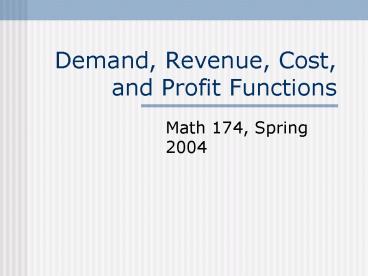Demand, Revenue, Cost, and Profit Functions - PowerPoint PPT Presentation
1 / 13
Title:
Demand, Revenue, Cost, and Profit Functions
Description:
qu is the quantity in single units. qk is the quantity in thousand units ... We are going to define Marginal Cost to be the price, in dollars per item, for ... – PowerPoint PPT presentation
Number of Views:797
Avg rating:5.0/5.0
Title: Demand, Revenue, Cost, and Profit Functions
1
Demand, Revenue, Cost, and Profit Functions
- Math 174, Spring 2004
2
Demand Function
- D(q) is the unit price at which q units of a
product can be sold - Experience suggest a quadratic demand function
- For your data, you will need to come up with a
function based on test market data - How should you do this?
3
Units of Demand Function
- Will use two variables (not used in text)
- qu is the quantity in single units
- qk is the quantity in thousand units
- Test market data must be scaled up to the
national level - At national level, demand is presented as the
unit price at which qk thousand drives can be
sold
4
Units of Demand Function
- We have the following proportion
- Note The size of your national market (in your
data) is given in millions. You will have to
rewrite this number in thousands so the units are
correct. - You can then solve the proportion for the
national sales (in Ks) - Round answers to nearest whole unit
5
Demand Curve
- Once you have the national sales (in Ks) for
each test market -- - Plot the points (qk vs. unit price)
- Fit a trend line to the data
- Show equation (make sure all coefficients go out
to 8 decimal places) - Use equation to determine points for demand curve
need a lot of points - Use points to plot a smooth demand curve
6
Revenue Function
- Revenue, R(qk), is given in millions of dollars
for selling qk thousand units - So, R(qk) D(qk)qk 1000
- This answer is in millions
- For example, if D(qk)119.95 and qk 893, then
R(qk)107,115,350 - We want the unit to be millions and also the
answer to be a smaller number (so we can work
with it easier) - We can divide our answer by 1,000,000 to get
about 107 million dollars - So, our formula should be R(qk)(D(qk)qk)/1000
7
Revenue Curve
- You need to use the data you generated for your
demand curve and determine what the corresponding
values are for your revenue function - Use R(qk) function determined on previous slide
- When you graph your revenue data, you will have
quantity (in Ks) along x-axis and total revenue
(in Ms) along y-axis
8
Cost Function
- If your total revenue is in millions of dollars,
then your total cost must be also - Total cost is the fixed cost plus the variable
cost - Fixed cost is in millions of dollars need to
rewrite it so the unit is millions - Example 21,600,000 is rewritten as 21.6 million
- You need to determine the variable cost for each
amount of product you are producing - We are going to define Marginal Cost to be the
price, in dollars per item, for production at a
given number of items
9
Variable Cost
- To determine the variable cost, you will need to
use the marginal cost of production - For example, if you produce 1,200 drives
- The first 500 thousand cost 115 per drive
- (5001000115)/1,000,000 (500115)/100057.5
million - The next 600 thousand cost 100 per drive
- (600100)/1000 60 million
- The rest cost 90 per drive
- (10090)/1000 9 million
- The sum of the results give the final variable
cost of 126.5 million
10
COST function
- To determine the total cost, you can add the
fixed cost and the variable cost - To do this for every quantity, it would be
tedious to determine a formula - Can use COST function located under USER DEFINED
formulas built in - If you are generating your data and graphs in a
new Excel workbook, you will need to copy the
COST module over from Marketing Focus.xls - Follow directions in slides 58-60 in Notebook or
on CD
11
Total Cost
- Regardless of how you calculate the total cost,
you will need to understand each step - Using the COST function make sure you
understand why you are entering what you are for
each of the arguments in the dialog box - You should have a column that has the total cost
for each particular quantity - Once you have the data, you should create a graph
that illustrates the cost display both the
revenue and cost on one set of axes - Why should you graph both curves together?
- Cost graph is quantity (Ks) vs. Total Cost (Ms)
12
Profit
- Since the total cost and the total revenue is in
millions, profit will also be in millions - Profit Curve will be quantity (Ks) vs. total
profit (Ms) - Create a curve for profit by subtracting total
revenue and total cost
13
What should you do?
- Start a new Excel file, generate the data for
your information - Do not forget to copy the COST module
- Create each one of the curves talked about
demand, revenue, cost, and profit - Work with the same units and coefficient
precision as is in the Class Project - I will be solving each of your projects and will
assume the same accuracy as the on-line text - Your information should match mine at the end of
the project - Do not put this off! Your work will pile up if
you leave too long - It will also be a part of the next homework
assignment































